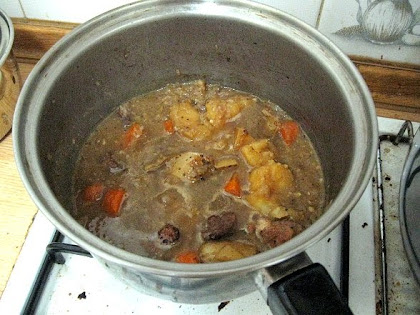How would mint change a curry?
I sometimes revisit to Mom's sour, minty prawn curry in my memories, feeling the prawns against my teeth before they yielded, releasing their goodness and adding to the spices and fresh, earthy and astringent herb in the gravy.
Instead of a full-fledged dish, I opted to make a curry sauce with mint, which I would then blitz with a blender and bring to a boil with some pieces of roast pork. But had I put a bit more thought into it, I'd have used red onion rather than shallot, because shallots are harder to prep.
I chopped the shallots roughly anyhow, since it was all going to be blended. I used fresh red chillies for heat and colour, along with a tomato, grated ginger and garlic, curry powder and a bit of turmeric powder.
The shallots were pan-fried first, and it seemed to be smoother and took less time with the wok than the stainless steel pot. The grated ginger and garlic went in, followed by the tomatoes. The whole mess soon cooked to a satisfying pulp that's well on its way towards gravy-hood.

The wok worked well. Too bad it didn't come with a lid. Nor were
there any pot lids available for it.
there any pot lids available for it.
A quick taste made me reach for the pot of salt. A good pinch went in, then a good stir to mix it well.
I lowered the heat and tossed in the sliced chillies, seeds and all, and stirred for a bit before adding the curry and turmeric powders. Once well stirred and cooked, I switched off the flame and allowed the spice paste to cool, while checking the rice.
Yes, I had some brown rice cooking around the same time. At first, I thought I'd "use the same amount of rice" I did for the previous dish. But it turned out that the amount was just right for me. Though a good handful ended up stuck to the bottom of the pot.
Excited to see the grains bubbling along nicely, I returned to the spice paste.
Oh dear, oh dear, might I need to add water? Thinking for a bit, I remembered the now-frozen left-over chicken stock from the previous day. I cut open the carton and scraped about two heaped tablespoons of the slushy stock to flavour the spice paste and cool it further.
I would add water later, when flushing out whatever sauce that was stuck in the blender pitcher after a good whizz with some fresh mint leaves.
One ringgit got me a small bunch of mint which was not in good shape overall, but it was fresh. I picked the better leaves and froze them in a zip-lock bag for later use.
I think I used several leaves too many. Some of them were big leaves, too. But it did taste different and nice.
Hungry and impatient, I dropped the "push mixture through the sieve" step and returned the blitzed gravy to the wok. I tossed most of the roast pork into the bubbling mix and let it simmer for a bit. My word, the aroma. What a time to run out of butter.
Pouring the finished dish into a bowl, I couldn't resist putting a finishing touch to it.
Did I, as makan kaki Melody put it, nail this dish. I'm not sure. Maybe I wasn't meant to. Curry is complicated and, after about a dozen attempts, one should be grateful that it's edible.
The taste was okay, but way too much mint. A sprinkle of sweetening might have made it better, but that got lost in the haze of cook, mind the pot, mind the stove and clean as you go. I'm terribly OCD about the latter - three or more dirty utensils (including cutlery and crockery) in the sink and I get uncomfortable.
Curries are best eaten with rice. Nothing soaks up and holds the gravy quite like it.
Because of that, I will "nail" this dish. Or get as close to nailing it as possible.
Categories:
Epicurean Editor
















































